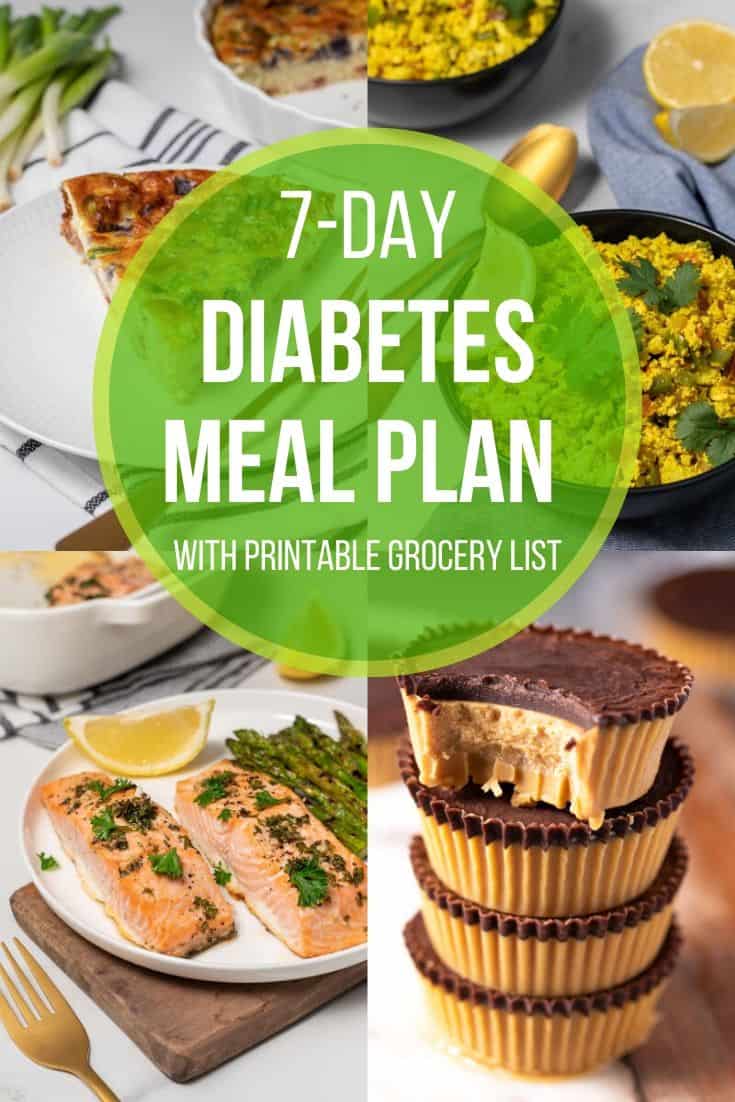This 7-day diabetes meal plan will give you an easy-to-follow plan for what and how much to eat to get the healthy nutrition you need as a person living with diabetes.
Equally importantly, all the food in this meal plan tastes great and motivates you to stick to the plan!
It includes instructions on how to find your daily calorie needs and adjust the meal plan to your goals (weight loss, maintenance, weight gain, etc.)
To make following the plans easier, it also includes a downloadable grocery list and a day-by-day overview that you can print out and put on your fridge or bring grocery shopping.
All of the recipes are low-carb so they fit the nutrition preferences of most people living with diabetes.
If you prefer a meal plan with even fewer carbs, you can follow our Ketogenic Meal Plan instead.

What is a good meal plan for people with diabetes?
A good diabetes meal plan is one that provides you with all the healthy nutrition you need while helping you keep your blood sugar level in your target range.
According to the American Diabetes Association’s 2019 nutrition guidelines, there are many different ways to create a healthy diabetes meal plan, but there is “growing evidence to show that low-carbohydrate eating patterns can benefit people with diabetes and prediabetes.”
This plan is what many will consider “moderately low carb” which means:
- Less than 25 grams of carbohydrates in each meal or snack
- Protein and healthy fats in every meal
- Plenty of fiber to aid digestion and help manage blood sugar levels (by slowing down the absorption of carbohydrates)
- No processed carbohydrates or added sugars
- Limited natural sugars (from fruit, etc.) that can cause blood sugar spikes
- Moderate in sodium
Of course, no meal plan will perfectly suit everyone. You may have specific dietary needs or food allergies to take into account or simply like different foods than what’s included in this plan. If so, use this plan as a starting point and substitute the meals that don’t work for you with something else with similar macronutrients.
How to find your daily calorie need
We all have different calorie needs. Your daily calorie need depends on your size, fitness level, daily activity, gender, etc.
When you are creating a healthy diabetes meal plan, your first step should therefore always be to calculate your “calorie equilibrium”, or how many calories you need each day to maintain your current weight.
You can learn exactly how to find your calorie equilibrium with 5 easy steps in this post: “How to Find Your Daily Calorie Need“.
Once you know your calorie equilibrium, you can adjust your daily calories up or down to meet your goals. If your goal is to lose weight, I recommend that you eat up to 500 calories less than your equilibrium each day (but no less than 1,200 per day). This should lead to a steady and healthy weight loss.
If you want to build more muscle mass (or just gain weight in general), start by eating 300-500 calories more than your equilibrium each day and see what happens. If you find that you are putting on a little too much fat, decrease your calories slightly.
How to use the meal plan
This is a 1600-calorie meal plan that can be adjusted to whatever number of daily calories you choose.
The meal plan has 3 main meals and 2 snacks per day and it tells you how many calories and carbohydrates are in each meal and snack.
If you need to adjust the calories, start by adding or removing a snack. If that isn’t enough to reach your calorie goal, adjust the servings of one or more main meals.
Vegetables are included as a separate line for each day but it’s recommended to split them up so you eat some vegetables with each main meal (or at least lunch and dinner). Vegetables are also great for grazing on throughout the day to keep hunger at bay.
Vegetables in this plan mean low-carb veggies like salad, broccoli, cucumber, etc. NOT carbs like beans, potatoes, etc. You can see a list of great low-carb veggies at the end of this post.
You can download a day-by-day overview of the meal plan HERE and print it and hang it on your fridge (or just keep it on your computer or phone) so you always know what to eat next.
Food prep and cooking
To make your meal prep for the week a little easier, you can find a downloadable and printable grocery list HERE that includes everything you need to make every meal.
Many of the meals can be made in large batches and stored in the fridge. Some meals are included on multiple days so you can cook for several days at the same time so always check the day-by-day plan before you start meal prepping.
7 -Day Diabetes Meal Plan
Day 1
Breakfast: 4 Egg Muffins (352 calories & 8 g carbs)
Snack: 5.2 oz (148 g) Greek yogurt (0%) + 1 oz. (28 g) almonds (248 calories & 12 g carbs)
Lunch: 1 serving Salad Niçoise (405 calories & 18 g carbs)
Snack: 3 oz. (85 g) shelled edamame (120 calories & 8 g carbs)
Dinner: 1.5 serving Quiche (401 calories & 10 g carbs)
Veggies: 20 oz. (4-5 cups, 570 g) vegetables enjoyed throughout the day – estimated 80 calories & 20 g carbs
Total: 1607 calories & 76 g carbs
Day 2
Breakfast: 4 Egg Muffins (352 calories & 8 g carbs)
Snack: 4 oz. (114 g) apple + 1 tsp. nut butter (155 calories & 20 g carbs)
Lunch: 1.5 serving Quiche (401 calories & 10 g carbs)
Snack: 2 servings Cottage Cheese Parfait with Berries (250 calories & 25 g carbs)
Dinner: 1 serving Rosemary Chicken (Tuscan Style) + 1 serving Cauliflower Mash (375 calories & 14 g carbs)
Veggies: 20 oz. (4-5 cups, 570 g) vegetables enjoyed throughout the day – estimated 80 calories & 20 g carbs
Total: 1613 calories & 97 g carbs
Day 3
Breakfast: 1.5 serving Cauliflower Oatmeal + 2 eggs (353 calories & 25 g carbs)
Snack: 4 oz. (114 gram) hummus (200 calories & 17 g carbs) Tip: Enjoy with some of the daily veggies
Lunch: 1 serving Peruvian Chicken Wrap (375 calories & 16 g carbs)
Snack: 5 oz. (143 gram) Shelled edamame (200 calories & 14 g carbs)
Dinner: 1.5 serving Mustard Baked Chicken Tenders + 3 oz. (86 g) cooked quinoa (382 calories & 21 g carbs)
Veggies: 20 oz. (4-5 cups, 570 g) vegetables enjoyed throughout the day – estimated 80 calories & 20 g carbs
Total: 1590 calories & 113 g carbs
Day 4
Breakfast: 1 serving Chia Seed Pudding (201 calories & 23 g carbs)
Snack: 4 oz. (114 gram) apple + 1 tsp. nut butter (155 calories & 20 g carbs)
Lunch: 1 serving Peruvian Chicken Wrap (375 calories & 16 g carbs)
Snack: 2 Sugar-free Chocolate Chip Cookie (330 calories & 19 g carbs)
Dinner: 1 serving Salmon with Lemon Butter + 3 oz. (86 g) cooked quinoa (439 calories & 17 g carbs)
Veggies: 20 oz. (4-5 cups, 570 g) vegetables enjoyed throughout the day – estimated 80 calories & 20 g carbs
Total: 1580 calories & 115 g carbs
Day 5
Breakfast: 1 serving Chia Seed Pudding + 2 eggs (345 calories & 24 g carbs)
Snack: 5.2 oz (148 g) Greek yogurt (0%) + 1 oz. (29 g) almonds (248 calories & 12 g carbs)
Lunch: 1 serving Salmon with Lemon Butter (400 calories & 14 g carbs)
Snack: 1 Sugar-free Chocolate Chip Cookie (165 calories & 9 g carbs)
Dinner: 1.5 serving Turkey Chili (348 calories & 25 g carbs)
Veggies: 20 oz. (4-5 cups, 570 g) vegetables enjoyed throughout the day – estimated 80 calories & 20 g carbs
Total: 1586 calories & 104 g carbs
Day 6
Breakfast: 1 serving Protein Pancakes + 2 tsp. nut butter (372 calories & 24 g carbs)
Snack: 1 serving Keto Peanut Butter Fat Bombs (247 calories & 3 g carbs)
Lunch: 1.5 serving Turkey Chili (348 calories & 25 g carbs)
Snack: 1 Sugar-free Chocolate Chip Cookie (165 calories & 9 g carbs)
Dinner: 1.5 serving Zucchini Lasagna (366 calories & 18 g carbs)
Veggies: 20 oz. (4-5 cups, 570 g) vegetables enjoyed throughout the day – estimated 80 calories & 20 g carbs
Total: 1578 calories & 100 g carbs
Day 7
Breakfast: 1 serving Cottage Cheese Pancakes + 1 tsp. nut butter (300 calories & 23 g carbs)
Snack: 5 oz. (143 gram) Shelled edamame (200 calories & 14 g carbs)
Lunch: 1.5 serving Zucchini Lasagna (366 calories & 18 g carbs)
Snack: 1 serving Keto Peanut Butter Fat Bombs (247 calories & 3 g carbs)
Dinner: 1.5 serving Tofu Scramble (Vegan) (357 calories & 25 g carbs)
Veggies: 20 oz. (4-5 cups, 570 g) vegetables enjoyed throughout the day – estimated 80 calories & 20 g carbs
Total: 1550 calories & 103 g carbs
Changing up the plan
If there’s a recipe in the plan you don’t care for, you can easily mix it up by picking other recipes from our recipe library. Simply choose recipes with similar calories and carbohydrates to those included in the plan above.
List of low-carb vegetables
This is, of course, not a comprehensive list of every low-carb vegetable in the world, so if your favorite vegetable isn’t on the list, look up how many carbs are in it yourself (just Googling it works for most vegetables).
- Arugula
- Asparagus
- Bamboo shoots
- Bok Choy
- Broccoli
- Cabbage
- Cauliflower
- Celery
- Cucumber
- Eggplant (aubergine)
- Fennel
- Kale
- Leeks
- Lettuce (all sorts)
- Mushrooms
- Peppers
- Pumpkin
- Radish
- Spinach
- Tomato
- Watercress
- Zucchini (Courgette)
Frequently Asked Questions
Q: Is this meal plan suitable for both type 1 and type 2 diabetes?
A: The 7 -Day Diabetes Meal Plan is suitable for people living with any type of diabetes unless your medical team has recommended you follow a specific different diet. Always defer to the guidance of your medical team. The plan is moderately low-carb but per the American Diabetes Association’s 2019 nutrition guidelines, the appropriate daily carbohydrate intake is personal, so please adjust accordingly.
Q: I practice intermittent fasting. Can I combine meals or skip snacks so I can eat everything in the 6-hour window where I don’t fast?
A: Yes, you can enjoy the meal plan and still practice intermittent fasting. Feel free to combine meals or skip snacks as long as you still eat enough calories to support your goals
Q: What do I do if I can’t follow the meal plan for every meal (because of work, social life, etc.)?
A: That’s OK, the meal plan is meant to make life easier, not harder. Try to match the daily calories and carbohydrates as close as you can but don’t stress too much about it.
Q: What if I’m allergic or don’t like some of the ingredients?
A: No worries, just substitute the ingredients you don’t want or simply make a different meal. Just try to match the calories and carbohydrates listed for the meal you don’t want
Q: What if I don’t cook?
A: Eating healthy can be done even if you don’t cook. Try choosing food options that match the daily calorie targets as a minimum. When you buy food at restaurants or pre-cooked at the supermarket, pay attention to how it’s prepared and try to look the food up online to help you with carb counting
Q: Can I continue using this meal plan after the first week?
A: Yes, you can use this meal plan until you grow tired of the meals. And when you do, simply substitute the meals for others in our recipe library or your own favorite recipes






Cathy
In the egg muffins it say 4. Is that correct?
Christel Oerum
Yes, 4 egg muffins
Chuck tye
McDonald’s style? Which is meat, cheese, egg, sourdough bread. That’s a lot of fat and carbs!
Christel Oerum
There’s a link to the Egg Muffins recipe in the meal plan
Mary Palmer
My wife is having trouble keeping her sugar down where it should be. She is so tired all the time and has no energy to do anything anymore. There are alot of the food mentioned that i know she don’t like. What can i do to help her eat better?
Christel Oerum
She might benefit from a conversation with a diabetes educator (CDCES) or a registered nutritionist (RD). Her doctor should be able to refer her. She should also have a conversation with her doctor about how she manages her blood sugars, it could be a question of adjusting medication or changing/adding
Sunita
Hi. If I don’t feel like having breakfast, can I skip this meal until midmorning? I ask this based on the fact that I was told to take my morning diabetes tablet with my breakfast. So is it okay to take my tablet without having eaten? Thanks
Christel Oerum
If you’re asked to take your medication with a meal, it’s most likely because that combination will reduce the risk of any discomfort/side effects. If you don’t want to eat breakfast you could ask your doctor if it’s ok that you take your medication with a different meal